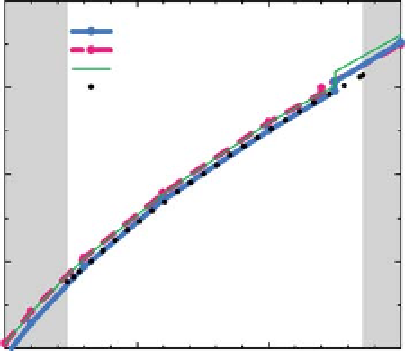Geoscience Reference
In-Depth Information
speeds in those different lithology. Understanding
of those properties must be completed before
setting mineralogical constraints on the seismo-
logically observed heterogeneity properties.
Using the elasticity and density data of each
lower mantle mineral summarized in the previ-
ous sections, here we evaluate the properties of
representative model rocks, pyrolitic and MORB
aggregates, at lower mantle pressures. To do this,
volume fractions of the mineral phases and the
Fe and Al concentrations in MgPv and Fp were
set to the values shown in Figure 7.9 according
to previous reports (e.g., Ono
et al
., 2001; Hirose
et al
., 2002; Irifune & Tsuchiya, 2007; Ricolleau
et al
., 2010). In pyrolite, they lead to Fe
/
(Mg
6.0
Pyrolite
MORB
Perovskitite
PREM
5.5
5.0
4.5
4.0
0
50
100
150
+
Fe)
P (GPa)
∼
of
10%, with the partition coefficient of Fe
between MgPv and Fp of
Fig. 7.10
Density profiles for pyrolite (solid lines),
MORB (dashed lines) and perovskitite (thin line)
calculated along the Brown and Shankland's geotherm
with the reference Earth value (black dots) (Dziewonski
and Anderson, 1981). The perovskitite's composition
was set to 100% Pv (or PPv) with
X
FeSiO3
=
0.35. These are con-
sistent with experimental values (Irifune
et al
.,
2010). Using reported
ab initio P
,
V
,
T
equation of
state of MgPv (Tsuchiya
et al
., 2005c), results are
corrected to include the temperature effect along
the normal mantle adiabat (Brown & Shankland,
1981). Calculated net density profiles of the two
rock models indicated that the MORB composite
is denser than the pyrolitic composite in most
of the lower mantle by
∼
12 mol%.
Shaded areas are out of the lower mantle range.
Computational uncertainties were found comparable
to the thickness of the lines. (See Color Plate 3).
0.03-0.04 g
/
cm
3
∼
cor-
responding to
1%. This value is the same as
previous estimation (Irifune & Tsuchiya, 2007),
but their densities become quite comparable in
the D
region, because the effect of the PPv phase
change is less pronounced in MORB due to the
smaller fraction of MgPv (Figure 7.10). Therefore,
MORB likely gets some negative buoyancy except
∼
in the lowermost mantle, but the density contrast
<
1% is substantially smaller than that needed for
its gravitational stabilization at the lowermost
mantle (
∼
3%) (Nakagawa & Tackley, 2005).
Figure 7.11 shows the elastic wave speeds cal-
culated for the pyrolitic and MORB aggregates at
2000 K based on the Voigt-Ruess-Hill average
combined with proposed temperature effects on
the elasticity (Wentzcovitch
et al
., 2004, 2006).
These velocities indicate that the two materials
have fairly comparable elastic wave velocities.
However, the pyrolite composition clearly gives
excellent agreement with the Earth values, sim-
ilarly to the previous analyses by (Marton &
Cohen, 2002; Wentzcovitch
et al
., 2004). More
silicic compositions are therefore expected to
give further lower reproducibility. A model with a
perovskite dominant bulk composition (perovski-
tite) was recently proposed for the lower mantle
chemistry based on
V
S
(Murakami, 2011). Density
and velocities of this composition (100% Pv with
Pyrolite
MORB
CaPv
10%
MgPv
(15%Fe,
10%AI)
34%
AI-Phase
22%
Fp
(15%Fe)
20%
MgPv
(5%Fe,
3%AI)
70%
SiO
2
22%
CaPv
22%
Fig. 7.9
Mineral volume fractions and the Fe and Al
concentrations in MgPv and Fp in the pyrolitic and
basaltic compositions.



